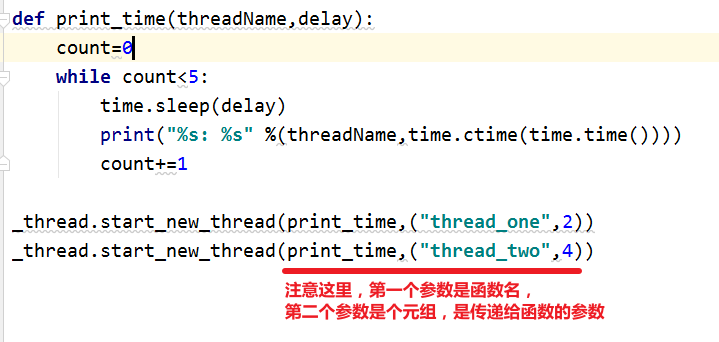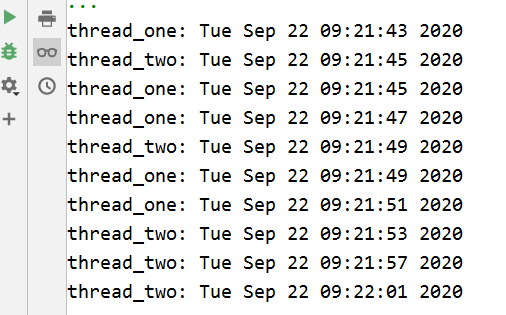python基础(11)多线程
多线程
多线程的优点:
- 使用线程可以把占据长时间的程序中的任务放到后台去处理。
- 用户界面可以更加吸引人,比如用户点击了一个按钮去触发某些事件的处理,可以弹出一个进度条来显示处理的进度。
- 程序的运行速度可能加快。
- 在一些等待的任务实现上如用户输入、文件读写和网络收发数据等,线程就比较有用了。在这种情况下我们可以释放一些珍贵的资源如内存占用等等。
每个独立的线程有一个程序运行的入口、顺序执行序列和程序的出口。但是线程不能够独立执行,必须依存在应用程序中,由应用程序提供多个线程执行控制。
每个线程都有他自己的一组CPU寄存器,称为线程的上下文,该上下文反映了线程上次运行该线程的CPU寄存器的状态。
线程可以分为:
- 内核线程:由操作系统内核创建和撤销。
- 用户线程:不需要内核支持而在用户程序中实现的线程。
_thread模块
调用 _thread 模块中的start_new_thread()函数来产生新线程,语法格式是:
_thread.start_new_thread ( function, args[, kwargs] )
注意: args - 传递给线程函数的参数,他必须是个tuple类型。
实例:

运行结果为:

注意:使用多线程时,建议使用try... except包起来:

threading模块
_thread 提供了低级别的、原始的线程以及一个简单的锁,它相比于 threading 模块的功能还是比较有限的。
threading 模块除了包含 _thread 模块中的所有方法外,还提供的其他方法:
threading.currentThread(): 返回当前的线程变量。threading.enumerate(): 返回一个包含正在运行的线程的list。正在运行指线程启动后、结束前,不包括启动前和终止后的线程。threading.activeCount(): 返回正在运行的线程数量,与len(threading.enumerate())有相同的结果。
除了使用方法外,线程模块同样提供了Thread类来处理线程,Thread类提供了以下方法:
run(): 用以表示线程活动的方法。
start():启动线程活动。
join([time]): 等待至线程中止。这阻塞调用线程直至线程的join() 方法被调用中止-正常退出或者抛出未处理的异常-或者是可选的超时发生。
isAlive(): 返回线程是否活动的。
getName(): 返回线程名。
setName(): 设置线程名。
使用 threading 模块创建线程:
我们可以通过直接从 threading.Thread 继承创建一个新的子类,并实例化后调用 start() 方法启动新线程,即它调用了线程的 run() 方法:
import time
import _thread
def print_time(threadName,delay):
count=0
while count<5:
time.sleep(delay)
print("%s: %s" %(threadName,time.ctime(time.time())))
count+=1
try:
_thread.start_new_thread(print_time,("thread_one",2))
_thread.start_new_thread(print_time,("thread_two",4))
except:
print("Error:无法启动线程")
import threading
exitFlag=0
class myThread(threading.Thread):
def __init__(self,threadId,name,counter):
threading.Thread.__init__(self)
self.threadId=threadId
self.name=name
self.counter=counter
def run(self):
print("开启线程:"+self.name)
print_time(self.name,self.counter,5)
print("退出线程:"+ self.name)
def print_time(threadName,delay,counter):
while counter:
if exitFlag:
threadName.exit()
time.sleep(delay)
print('%s: %s'%(threadName,time.ctime(time.time())))
counter-=1
thread1=myThread(1,'Thread-1',1)
thread2=myThread(2,'Thread-2',2)
thread1.start()
thread2.start()
thread1.join()
thread2.join()
print("退出线程")

